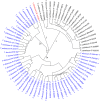Genetic Diversity and Resistance to Fusarium Head Blight in Synthetic Hexaploid Wheat Derived From Aegilops tauschii and Diverse Triticum turgidum Subspecies
- PMID: 30619402
- PMCID: PMC6298526
- DOI: 10.3389/fpls.2018.01829
Genetic Diversity and Resistance to Fusarium Head Blight in Synthetic Hexaploid Wheat Derived From Aegilops tauschii and Diverse Triticum turgidum Subspecies
Abstract
Synthetic hexaploid wheat (SHW) can serve as a bridge for the transfer of useful genes from Aegilops tauschii and tetraploid wheat (Triticum turgidum) into common wheat (T. aestivum). The objective of this study was to evaluate 149 SHW lines and their 74 tetraploid parents for their genetic diversity, breeding values and inter-genomic interactions for resistance to Fusarium head blight (FHB). The genetic diversity analysis was performed based on the population structure established using 4,674 and 3,330 polymorphic SNP markers among the SHW lines and tetraploid parents, respectively. The results showed that all T. carthlicum and most T. dicoccum accessions formed different clusters and subpopulations, respectively, whereas all the T. durum, T. polonicum, T. turgidum, and T. turanicum accessions were clustered together, suggesting that T. durum was more closely related to T. polonicum, T. turgidum, and T. turanicum than to T. dicoccum. The genetic diversity of the SHW lines mainly reflected that of the tetraploid parents. The SHW lines and their tetraploid parents were evaluated for reactions to FHB in two greenhouse seasons and at two field nurseries for 2 years. As expected, most of the SHW lines were more resistant than their tetraploid parents in all environments. The FHB severities of the SHW lines varied greatly depending on the Ae. tauschii and tetraploid genotypes involved. Most of the SHW lines with a high level of FHB resistance were generally derived from the tetraploid accessions with a high level of FHB resistance. Among the 149 SHW lines, 140 were developed by using three Ae. tauschii accessions CIae 26, PI 268210, and RL 5286. These SHW lines showed FHB severities reduced by 21.7%, 17.3%, and 11.5%, respectively, with an average reduction of 18.3%, as compared to the tetraploid parents, suggesting that the D genome may play a major role in reducing disease severity in the SHW lines. Thirteen SHW lines consistently showed a high level of FHB resistance compared to the resistant check, Sumai 3, in each environment. These SHW lines will be useful for the development of FHB-resistant wheat germplasm and populations for discovery of novel FHB resistance genes.
Keywords: Aegilops tauschii; Fusarium head blight; Triticum turgidum; genetic diversity; synthetic hexaploid wheat; tetraploid wheat; wheat.
Figures




References
-
- Börner A., Ogbonnaya F. C., Röder M. S., Rasheed A., Periyannan S., Lagudah E. S. (2015). “Aegilops tauschii introgressions in wheat,” in Alien Introgression in Wheat: Cytogenetics, Molecular Biology, and Genomics, eds Molnár-Láng M., Ceoloni C., Dolezel J. (London: Springer; ), 245–272.
-
- Brisco E. I., Brown L. K., Olson E. L. (2017). Fusarium head blight resistance in Aegilops tauschii. Genet. Resour. Crop Evol. 64 2049–2058. 10.1007/s10722-017-0495-3 - DOI
LinkOut - more resources
Full Text Sources
Research Materials
Miscellaneous

